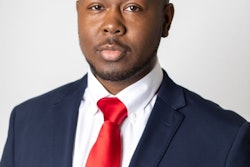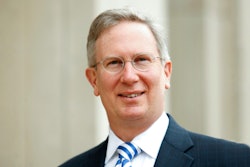The Journey for Jackson State
A source of pride for its community, this HBCU has emerged as a research and public service leader in Mississippi.
By Ronald Roach
JACKSON, Miss.
In recent years, construction cranes have loomed over the bustling campus of Jackson State University. The historically Black school of more than 8,000 students is undergoing a building boom, evident by recently constructed buildings that have blended with historic structures. Located at the southern end of the city, the Jackson State campus stands out as one of the few vibrant areas in this economically struggling section of Mississippi’s majority-Black capital city.
“I feel like now we are as close to being a major university as we’ve ever been,” says
Dr. Hillard Lackey, Jackson State’s national alumni president and an adjunct professor of history and geography. “We’ve come from being a college in the corner to being an active participant in world affairs.”
As a youngster growing up in Jackson, Andrell Harris believed fervently that he would leave his hometown to attend college. Now a junior at Jackson State, he says he grew interested in the school as a teenager after he encountered people affiliated with its outreach programs. It also helped that his mother is a Jackson State alumna, and that the finance major had started a local vending machine business while he was in high school.
“I realized that Jackson State had a lot to offer me. And now I can’t imagine having gone anywhere else for college,” he says.
A sense of pride is palpable among those who count themselves in the Jackson State community. In addition to taking pride in new buildings, such as the $22 million engineering building and the $24.5 million student union that are currently under construction, the school has gained a national reputation for scientific research in chemistry and environmental science. It has also become a national leader in community-based health disparities research with regard to HIV/AIDs and heart disease.
Founded in 1877, Jackson State has emerged as one of Mississippi’s leading research institutions as well as one of the top HBCUs in the country for research. Its $56 million sponsored research portfolio in the 2005-2006 academic year put the school second only to Howard University among HBCUs. In 2002, Jackson State was named a “comprehensive university” in a desegregation settlement plan, putting it on par with the University of Mississippi, Mississippi State University and the University of Southern Mississippi. And last year, the school earned the Carnegie classification ranking of a “high research activity” university.
Of the state’s eight public universities, three are historically Black.
“I’m very impressed with the progress at [Jackson State] over the past five years. When you go on the campus, you can see the changes to the physical plant. And the overall quality in the academic programs has been consistent,” says Dr. James T. Minor, an assistant professor of higher education at Michigan State University and a graduate of Jackson State.
An expert on HBCUs, Minor says his alma mater has grown into a comprehensive university despite being underfunded by both state and federal governments. For decades, Mississippi has operated under federal scrutiny as it sought to resolve the landmark higher education desegregation case. In 1975, Mississippi resident Jake Ayers Sr., and several other Black plaintiffs, including U.S. Congressman Bennie Thompson, D-Miss., charged in a lawsuit, Ayers v. State of Mississipi, that the state had long neglected its historically Black schools. The U.S. Supreme Court ruled in favor of the plaintiffs in 1992. In 2004, Mississippi reached a $503 million settlement that includes funding improvements at the three historically Black universities.
Although some of the settlement funding has benefited Jackson State, Minor says much of the school’s recent progress is the result of sound planning and solid performance. “In many ways, it’s due to good leadership,” he says.
Built on a solid Foundation
Jackson State President Ronald Mason Jr., an attorney and a former general counsel at Tulane University, gets considerable credit for the accomplishments the university has experienced in the past seven years. Appointed in 2000, he has helped secure millions of dollars in investments, which launched the current construction boom. So far, he has overseen the construction of a new business school building, a liberal arts building and several athletic facilities. He has also expanded the school’s role in the community, becoming more involved in local economic development and public school reform. There has also been a dramatic increase in research by Jackson State’s science and public health faculty during Mason’s presidency.
He credits prior administrations with providing a solid foundation on which to build new initiatives. “There were more things going on here with the potential to build on than I realized before I actually started working here,” Mason says. “Federal agency relationships were as good as I had ever seen. There was a caring, hands-on approach of the faculty. The graduates were out getting jobs in places that I wasn’t aware of, so we had a lot to build on.”
Jackson State veterans single out Dr. John A. Peoples, the school’s president from 1967 to 1984, for putting the school on a path that took it from a teachers college to a comprehensive university. Lackey, a native of the Mississippi Delta, says HBCUs offered a lifeline for individuals like himself, who were desperate to escape a life of tenant farming on cotton plantations.
“When I came here, we were trying to survive, period. Jackson State was trying to educate Black folks primarily as teachers,” Lackey says of his student days in the early 1960s.
That would change with the Peoples presidency. A Jackson State graduate, Peoples had earned a doctorate in mathematics from the University of Chicago and later rose through Jackson State’s administrative ranks to become its president.
“Peoples decided that the school ought to become a first-class institution,” Lackey says.
The late 1960s and early ’70s were an uncertain and turbulent time for Mississippians. The successes of the civil rights movement were transitioning into anxiety over the country’s involvement in the Vietnam War. But under People’s leadership, Jackson State would begin its transformation into one of Mississippi’s most competitive higher education institutions. But the transition wouldn’t be quick, easy or painless. In 1970, local police shot and killed a Jackson State student and a 17-year-old city resident during a campus protest, provoking outrage from Americans nationwide.
According to Lackey, the city’s then majority-White population had little or no love for the presence of Jackson State and was not inclined to support efforts to expand or enhance the school. Despite the opposition, Peoples found ways to improve the school by prevailing upon the faculty and administration to seek non-state-based funding and support. He also pushed faculty members to earn their doctorates.
“At the time when I went back to Jackson State in 1967, there may have been five people out of a faculty of more than 100 that had Ph.D.s,” Lackey says.
Granted the urban university status in 1979, Jackson State has sought involvement in urban planning, community health outreach, local economic development initiatives and local school reform, which are functions urban campuses often tackle.
“Peoples wanted Jackson State to have a role in Jackson similar to what the University of Alabama-Birmingham and the University of Memphis were doing in their cities,” Lackey explains.
Dr. Arthur James Hicks, the director of the National Science Foundation’s Louis Stokes Alliances for Minority Participation, says that the 1960s to the 1990s proved a pivotal era for HBCUs that held ambitions of developing into research-oriented,comprehensive universities. A number of Black college leaders, allied with Congressional Black Caucus members, successfully lobbied the federal government to make significant research and capacity-building dollars available to HBCUs.
Hicks says Jackson State and several other public HBCUs, including Florida A&M, North Carolina A&T and Tennessee State universities, have been among the most aggressive at utilizing federal dollars to develop graduate programs. They are also leading the charge in sponsoring research, particularly in the science, technology, engineering and math fields. Some private HBCUs, most notably Clark Atlanta, Hampton, Howard and Tuskegee universities, have also been active in developing their science and technology research portfolios, he says.
“Visionary leaders working with smart administrators and project managers, and productive and talented faculty have made selected HBCU campuses into competitive research institutions,” Hicks says.
Keeping With the Mission
By the time Mason arrived on campus, Jackson State had established doctoral programs in a number of disciplines. In 1982, the university graduated its first doctorates, Ed.D. recipients specializing in early childhood education. Jackson State’s first doctorate in educational administration and supervision came in 1994, according to Dr. Dorris Robinson-Gardner, dean of the graduate studies division. In the 1990s, Jackson State introduced doctoral programs in public administration, urban and regional planning, social work, business administration, clinical psychology, environmental science and chemistry. More recent doctoral programs, developed mostly during Mason’s presidency, have been in urban education leadership and public health.
“We developed these programs in keeping with our mission as an urban university. And there was clearly a state need for them,” Robinson-Gardner says.
With growth in graduate programs occurring, the push by Jackson State faculty to seek sponsored research and infrastructure-building grants also increased. Dr. William McHenry, a former National Science Foundation administrator who now runs Jackson State’s Mississippi e-Center facility and business incubator, recalls how university administrators worked diligently in the early ’90s to organize the school’s science research programs. McHenry and other NSF program officers provided advice to help the school’s faculty maximize their use of NSF funds.
“They listened to us and got their research programs aligned for accountability and to be outcome-oriented,” he says.
Dr. Felix A. Okojie, the vice president for research development and federal relations at Jackson State, says the graduate program development and other groundwork of the ’90s reaped impressive growth in research. Between 2001 and 2006, annual sponsored research jumped from $14 million to $56 million, according to Okojie. Nearly $20 million of the 2005-2006 funding went to researchers in the College of Science, Engineering and Technology.
“We’ve gone from being able to support five postdoctoral scholars at the college to 30 over the past five years due to the increase in research activity,” Okojie says.
Other generators of significant research dollars have included the College of Public Service, which houses the School of Public Health; the Jackson Heart Study project; the university’s Mississippi Urban Research Center; and several other university research centers.
More Challenges Ahead
As Jackson State officials anticipate how the school’s share of the Ayers settlement will help guide future growth, they remain cautious. For his part, however, Mason candidly proclaims that one of his goals is for Jackson State to become the most recognized and most competitive HBCU in the United States. He refers to it as being “America’s public HBCU.”
“We really are uniquely situated. If you’re going to build America’s public HBCU, why not build it in the capital city of the Blackest state in the country?” he asks.
For now, that means developing a new strategic plan to succeed the one Mason and a 17-member national panel crafted not long after he landed at Jackson State. The previous panel “spent about a year putting together a plan called the Millennium Agenda for Jackson State,” he says.
“Most of which you see around here that’s happened over the last five to six years has all been in accordance with that plan. We had five strategies and that was broken down into 19 programs and something like 200 action steps,” Mason says. “Now it’s time to do another strategic plan on which we’re about to get started.
This next piece is going to be more internal and focused on academics primarily.”
Officials say they are optimistic that Jackson State’s growth, which includes new and renovated dormitories now under construction as well as a relatively new engineering program, will help grow overall undergraduate enrollment. Dr. Robert W. Whalin, the university’s associate dean for engineering, says it looks promising that the engineering program will receive accreditation later this year. The new 90,000 square-foot engineering building is scheduled for completion in spring of 2008, according to Whalin.
“I expect that once we get our program accredited and we finish the new building, we’ll see considerably higher demand for engineering,” he says, noting that the school currently enrolls more than 500 students.
To take advantage of certain Ayers settlement funds, Jackson State must maintain 10 percent non-Black enrollment for at least three consecutive years. Achieving that goal will make the university eligible to receive 43.4 percent of the interest proceeds from a $70 million publicly funded endowment and a $35 million privately funded endowment. According to the Mississippi Board of Trustees of State Institutions of Higher Learning, Jackson State’s non-Black enrollment for the 2005-2006 academic year was 7.1 percent.
Of the three HBCUs receiving funds through the Ayers settlement — Jackson State, Alcorn State University and Mississippi Valley State University — only Alcorn State has met the
10 percent threshold.
In the meantime, Jackson State officials have plunged ahead with a major fundraising drive for the first time since the 1980s.
The Campaign for Jackson State, expected to be formally announced this year, is critical to improving student chances for success at the university, Mason says. The $50-million campaign, the largest in Jackson State’s history, is focused on student financial assistance, faculty and staff development. The silent phase of the campaign, which began in summer 2004, has raised approximately $16 million in gifts and pledges. The campaign will end in 2010.
“The gap between financial aid and the cost of attendance is why we’re doing a fund-raiser now,” he says. “When we run out of money, we just can’t serve that last 300 or 400 students that we would like to serve. What we have to do is get the money to serve the students.”
© Copyright 2005 by DiverseEducation.com


















